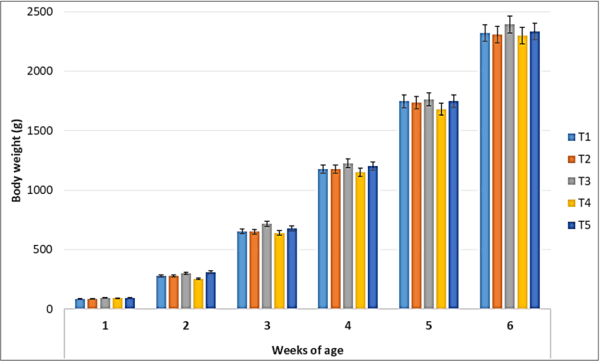Introduction
Lipids are the primary source of energy for animals, and the digestibility of fats determines the amount of energy that can be obtained by an animal from dietary fat. The age of birds influences the digestibility of fats and poor absorption is a problem in very young birds. The absorption of dietary fat is physiologically restricted in young animals due to low levels of natural lipase production and low rates of bile salt generation (Tancheroenrat et al., 2014) [10]. These physiological limitations of the digestive system of poultry can be overcome by the exogenous supplementation of emulsifiers, especially in the early stages of growth, which allows chicks to improve fat digestion and absorption, thereby increasing the availability of metabolic energy and improving growth performance (San Tan et al., 2016) [9].
The inclusion of dietary emulsifiers also has distinct benefits on fat assimilation in the later stages of broiler production, allowing better growth performance and return on investment. Emulsifiers act by splitting fat globules and extending the active surface of fats, permitting better action of enzymes, which hydrolyse glyceride molecules into fatty acids, and favor the formation of micelles, consisting of lipolysis products. This greatly facilitates lipid absorption by creating a diffusion gradient and boosts absorption (Haetinger et al., 2021) [5]. The present study was undertaken to evaluate the efficacy of an in-feed emulsifier, AV/PFE/15 (M/s Ayurvet Limited India), on the performance, carcass characteristics, lipid metabolism and immunity of broiler chicken.
Material and Methods
The experiment was held at the Department of Poultry Science, Post Graduate Institute of Veterinary and Animal Sciences, Akola, India (20.70° N, 77.07° E, 287 MSL) during February to March, 2017. The study protocol was approved by the Institutional Animal Ethics Committee (IAEC; approval number 312/01/2017, dated 27.01.2017).
Experimental birds and management
225 straight-run one-day-old commercial Vencobb broiler chicks were randomly allocated to one of five treatment groups, each having three replicates of fifteen birds (Table 1), and reared till 6 weeks of age under standard rearing practices. The birds were fed ad libitum and had unlimited access to water throughout the period of the experiment. Immunization against Newcastle Disease (ND; B1 strain) and Infectious Bursal Disease (IBD; intermediate strain) was performed on days 7 and 14, respectively, followed by booster doses on days 21 (B1 strain) and 28 (IBD) as per standard practice.
Table 1: Experimental design of the study. Each group consisted of three replicates of fifteen birds each.
Parameters recorded
Performance parameters such as body weight, feed intake, and feed conversion ratio were recorded at weekly intervals. Mortality was recorded daily. Feed efficiency and mortality were used to calculate Broiler Farm Efficiency Index (BFEI).
At the end of week 6, two birds from each replicate were randomly selected, starved for 12 hrs with ad lib access to drinking water and exsanguinated by jugular venesection. The carcasses were kept in hot water for 3-4 minutes and feathers were removed manually. Thereafter, carcass traits such as dressing, breast meat yield, abdominal fat and giblet yield were recorded and expressed on live weight basis. Serum lipid profile was determined at 6 weeks of age. Immunological response to vaccination was assessed in terms of HI titre to ND virus and antibody titre to IBD vaccine at weeks 3 and 6 of age.
Statistical analyses
Statistical inferences were drawn on the basis of critical difference test and analysis of variance (ANOVA).
Results and Discussion
The study aimed at evaluating the efficacy of the addition of an emulsifier, AV/PFE/15, on the performance, carcass characteristics, lipid metabolism and immunity of broiler chicken.
Growth performance
Weekly body weights, feed consumption, FCR, mortality and production efficiency indices are depicted in Figures 1-3.
Fig 1: Weekly cumulative body weights. T3 had highest body weight among groups, followed by group T5.
Fig 2: Weekly cumulative feed consumption. T3 had lowest feed consumption among groups, followed by group T5.
Fig 3: FCR, mortality and farm efficiency indices. T3 had best FCR and production efficiency among groups, followed by group T5.
As can be seen from the results, Group T3 almost consistently had the highest weekly body weight and the lowest weekly feed consumption. All groups recorded nil mortality, except group T4. However, all of the above differences between the groups were statistically insignificant (p> 0.05). Due to the highest body weight gain, lowest feed consumption and nil mortality, group T3 fared the best (p< 0.05) FCR and farm efficiency among groups, followed by group T5. Interestingly, both T3 and T5 had better production efficiencies than group T1 albeit dietary energy-restriction, suggestive of the efficacy of AV/PFE/15 as an emulsifier.
Dietary supplementation with emulsifier improved the growth performance (body weight, production index, and feed conversion ratio) of broilers. This is in agreement with the findings of Kamran et al. (2020) [6], where the improved growth performance was linked to increased dry matter and fat assimilation. Haetinger et al. (2021) [5] also found that supplementation of lysophospholipid-based bio-emulsifier in broiler chicken fed a standard or re-formulated diet increased fat digestion and absorption, resulting in improved performance, digestibility and return on investment. According to Zhao et al. (2015) [14] emulsifiers promote the integration of micelles in the intestinal lumen, which increases fat digestibility.
Likewise, dietary supplementation with feed emulsifier also appeared to significantly (p< 0.05) ameliorate the alterations in carcass characteristics, lipid profile, and immune responses brought about by the restriction in dietary energy. The values of carcass characteristics, serum lipid profile and vaccine titers have been shown for comparison in Table 2.
Table 2: Mean ± S.E. values of carcass traits, serum lipid profile and vaccine titers of experimental birds
a,b,c Values bearing different superscripts within a row differ significantly
Our findings are in contradiction to those of Aguilar et al. (2013) [1] and Zampiga et al. (2016) [12], who observed improvements in feed efficiency but not carcass traits in broilers receiving feed emulsifiers. However, in near complete agreement with the findings of our study, Bontempo et al. (2018) [3] have also reported the ability of a synthetic feed emulsifier to positively influence growth performances, carcass dressing and lipid metabolism in broilers. Of late, significant improvements in the carcass traits besides the growth characteristics of emulsifier-supplemented broiler chicken have also been reported by Ghazalah et al. (2021) [4] . Our findings showed that dietary energy-restriction caused a lowering of the specific immune response to vaccines, which was reversed (p> 0.05) upon dietary supplementation with emulsifier. Liu et al. (2013) [7] also reported the ability of infeed emulsifiers to significantly increase the spleen and bursal indices, and enhance the serum levels of IgA and IgM in broilers. Similarly, significant improvements in specific responses to NDV and IBD were also reported by AllahyariBake and Jahanian (2017) [2] in broiler chicken receiving dietary supplementation with lysophosphatidylcholine. Further, the dietary inclusion of emulsifiers in energy-restricted conditions has been shown to reverse depression in non-specific immune functions in other species as well (Medagoda et al., 2021; Wangkahart et al., 2022) [8, 11]. These improvements in specific and non-specific immune responses may be attributed, at least in part, to the modulation of gut microbiota and reduction in oxidative changes (Liu et al., 2013) [7]
Conclusion
In conclusion, the exogenous emulsifier AV/PFE/15, when supplemented @ 250 g/tonne of feed, improved performance, carcass characteristics, lipid metabolism and immunity in energy-restricted broilers. Overall, the results indicate that AV/PFE/15 is an efficacious feed emulsifier for use in broiler chicken.
This article was originally published in The Pharma Innovation Journal 2022; SP-11(1): 1119-1123. The Pharma Innovation Journal 2022; SP-11(1): 1119-1123.

















.jpg&w=3840&q=75)